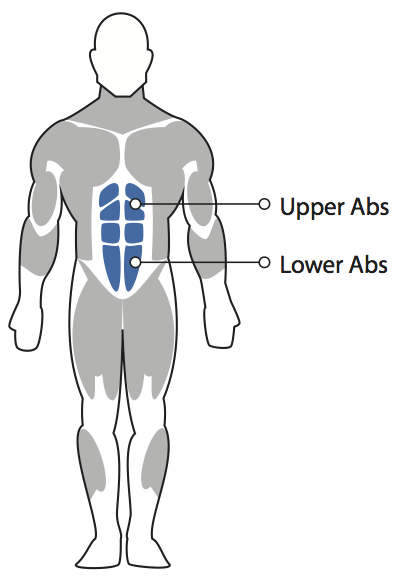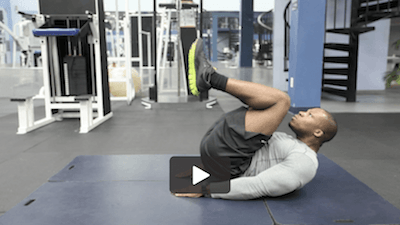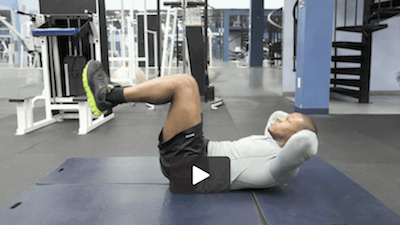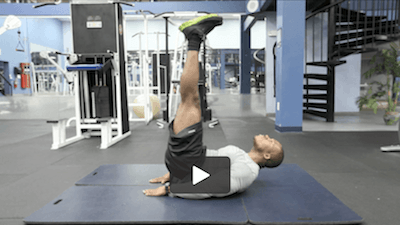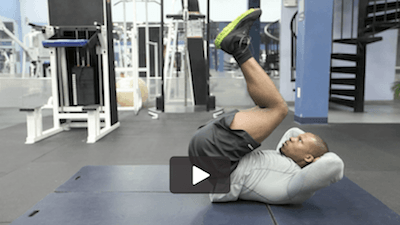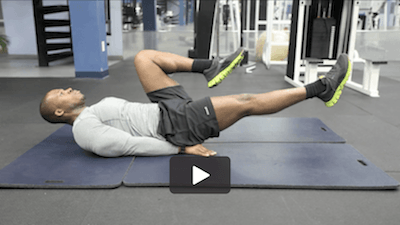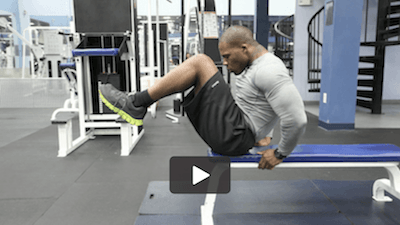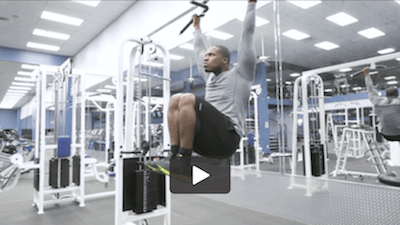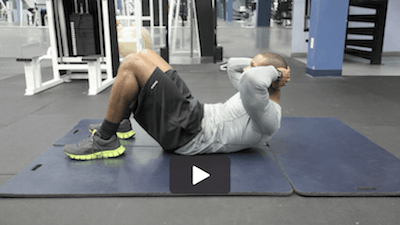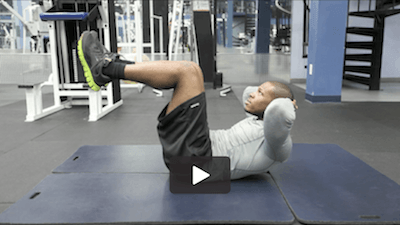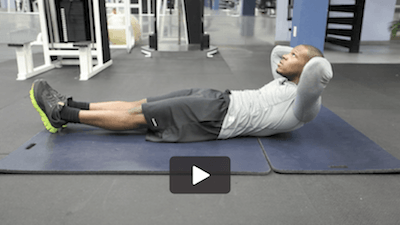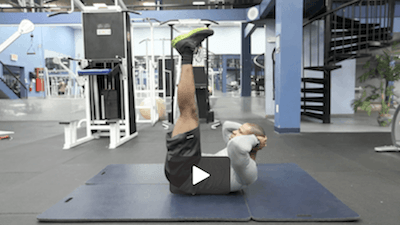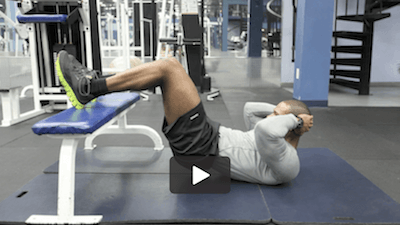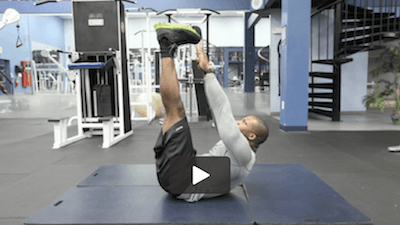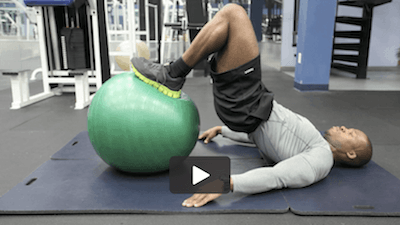The rectus abdominis is the most visible abdominal muscle group; it is responsible for the six-pack. These muscles play a role in maintaining posture. The rectus abdominis muscles can be broken down into two groups: the lower abdominals and upper abdominals. Below, find EMG’s 17 Lower Ab Exercises and Upper Ab Exercises.
Find additional EMG abdominal exercises at the following links:
- Oblique Exercises
- Transverse Abdominal Exercises
- Combination Abdominal Exercises
- Ab Workouts for Men
Page Table of Contents
Lower Ab Exercises
Reverse Crunch
The reverse crunch is one of the primary lower ab exercises. As the name suggests, it works the lower abs the same way a crunch works the upper abs. This exercise is usually performed with the user’s hands behind his head, forcing the user to keep his body steady by engaging his core. This is the ideal position, but the exercise may be performed with the hands flat on the ground for support if the user requires more stabilizing. Once the user has become accustomed to the exercise though, the behind the head hand placement should be used. This is a safe exercise for those with back pain, especially given the short range of motion. However, depending on the position of the back problem, the bending of the low back should be problematic. If that is the case, this exercise should not be performed.
Knee Raises
Knee raises are another one of the primary lower ab exercises. They are usually performed with the hands on the floor to provide support throughout the exercise. Those who want to balance using only their core muscles may put their hands behind their head or neck. As with most core exercises, this exercise should be performed slowly and deliberately. The user should concentrate on engaging the core throughout the whole motion. This is a safe exercise for those with back problems and may be a preferred alternative to performing the exercise hanging.
Modified Knee Raise
The knee raise is another one of the primary lower ab exercises. The knee raise is usually performed with the hands on the floor to provide support throughout the exercise, but those who want to balance using only their core muscles may put their hands behind their head or neck. As with most core exercise, the knee raise should be performed slowly and deliberately. The user should concentrate on engaging the core throughout the whole motion. The bending of the knee allows the user to prevent any undo stretching in the hamstrings and low back. This is a safe exercise for those with back problems and may be a preferred alternative to the performing the exercise hanging.
Hip Raises
Hip raises are one of the more complex lower ab exercises. They primarily work the lower abs, with a secondary workout to the upper abs. What makes the hip raise more complex than some other core exercises is that the user must keep the upper abs engaged for stability while raising the hips upwards, engaging the lower abs. Usually, this exercise is performed with the hands flat on the ground. This hand position helps provide balance for those with less core training experience or who are adjusting to a new exercise. If the user wants to use only the core muscles for balance, the hands can be put behind the head or neck. This exercise should be performed slowly and deliberately rather than quickly.
Bent Leg Hip Raise
The bent leg hip raise is a basic core exercise for strengthening the lower abs. This exercise works the lower abs in the same way as a crunch works the upper abs. By bending the leg, the user should not feel a stretch in the hamstring, allowing him to focus on just the abs. Typically, the hands are put behind the head (see video above) but the raises may be performed with the hands across the chest or on the floor for balance. As this is a shorter motion, effort should be made to perform the exercise in a controlled manner rather than rapidly. This exercise is a safe core exercise for those with lower back problems, however, the user should be careful not to pull the legs past the point of any strain.
Cycling Knee Raises
Cycling knee raises are another one of the more advanced lower ab exercises. They require the user to demonstrate both balance and control throughout the exercise. The user may help balance himself by placing his hands flat on the floor (see video). If the user is comfortable, he may place his hands behind his head or neck when performing the exercise, engaging more of the core to balance. Although cycling knee raises resemble peddling a bicycle, this exercise should be performed slowly. If the user finds himself off balance, it is likely that he is performing the exercise too quickly. This is a safe exercise for those with low back pain to perform as long as the motion remains slow and controlled throughout. Those with back pain may find the switching from leg to leg to be problematic for the back. If that is the case, the user may perform all the repetitions with one leg before switching to the other.
Seated Knee Raise
The seated knee raise is a variation on hanging knee raises, one of the primary hanging lower ab exercises. It works the lower abs. It also may be an easier exercise to perform for those with back problems and those who are new to core exercises. This exercise removes the need for constant core stabilization. This does not mean that the stabilizing muscles are not being used. By performing the exercise seated, the user is more stabilized and can focus on the lower abs more. This is a safe exercise for those with low back pain to perform. However, it is important to not bring the legs up too far. This may cause a round in the low back, leading to discomfort.
Hanging Knee Raises
Hanging knee raises are one of the primary hanging lower ab exercises. They can be performed in three different ways. The first way to perform them is by hanging from a pull up bar (as seen in the video above). This manner provides the most complete core exercises of the variations, but it may be more advanced than some users are ready for. If the user’s hands or back muscles are not strong enough to hang, arm straps may be used. This allows the user to hang from the bar without using his own strength to do so while still having to use his core muscles to limit body sway.
The final variation of hanging knee raises is performing them in a captain’s chair. Use of the captain’s chair removes the “hanging” from the exercise which in turn does not require the user to utilize his core muscles to limit body sway. Therefore, this variation should only be performed at the very start of working the core in addition to another variation.
Hanging Knee Raise: Single Leg Alternating
Single leg alternating hanging knee raises are another one of the primary hanging lower ab exercises. They can be performed in three different ways. The first way to perform single leg alternating hanging knee raises is by hanging from a pull up bar (as seen in the video above.) This manner provides the most complete core exercises of the variations, but it may be more advanced than some users are ready for. If the user’s hands or back muscles are not strong enough to hang, arm straps may be used. This allows the user to hang from the bar without using his own strength to do so while still having to use his core muscles to limit body sway.
The final variation of single leg alternating hanging knee raises is performing them in a captain’s chair. Use of the captain’s chair removes the “hanging” from the exercise which in turn does not require the user to utilize his core muscles to limit body sway. Therefore, this variation should only be performed at the very start of working the core in addition to another variation.
Lower Ab Exercises Video Playlist
Upper Ab Exercises
Crunches
Crunches are the primary exercise for working the upper abdominal muscles. Almost all upper ab exercises are variations of this basic motion. A common mistake when performing this exercise is to let the shoulder blades go flat on the ground between repetitions. By letting the shoulder blades go flat on the floor, the user disengages the core muscles, making the exercise less effective. The user should also be sure not to let his feet come off the ground during the exercise. It is also important not to pull the head and neck upwards with your hands. Not only could this lead to a neck strain, but it makes the upper abs work less. This exercise should be performed using only the upper abs to perform the motion. The hands and arms are just for support and balance.
Crunches: Knees Up
Crunches with the knees up is a common variation on one of the primary upper ab exercises, the crunch. By putting the knees up, the user must engage his core to maintain balance throughout. The lower abs are also engaged by keeping the legs in place and off the ground. A common mistake when performing this exercise is to let the shoulder blades go flat on the ground between repetitions. By doing this, the user disengages the core muscles, making the exercise less effective. It is also important not to pull the head and neck upwards with your hands. Not only could this lead to a neck strain, but it makes the upper abs to less work.
Crunches: Legs Straight Out
Crunches with the legs straight out is a common variation on one of the primary upper ab exercises, the crunch. By having the legs straight out, the user is more stable and can therefore isolate the upper abs more. The upper abs also have to work harder to complete the crunch because the user can not press down with his feet for leverage. It is important to keep the legs flat on the ground throughout the motion. Doing so keeps the core engaged throughout. A common mistake when performing this exercise is to let the shoulder blades go flat on the ground between repetitions. By doing this, the user disengages the core muscles, making the exercise less effective. It is also important not to pull the head and neck upwards with your hands. Not only could this lead to a neck strain, but it makes the upper abs to less work.
Crunches: Legs Straight Up
Crunches with the legs straight up is a common variation on one of the primary upper ab exercises, the crunch. By putting the legs up, the user must engaged his core to maintain balance throughout. The lower abs are also engaged by keeping the legs in place and off the ground. A common mistake when performing crunches is to let the shoulder blades go flat on the ground between repetitions. By doing this, the user disengages the core muscles, making the exercise less effective. It is also important not to pull the head and neck upwards with your hands. Not only could this lead to a neck strain, but it makes the upper abs work less.
Crunches: Raised Hips
Crunches with raised hips is another common variation on one of the primary upper ab exercises, the crunch. By having the the feet on a bench, the user is more stable and can therefore isolate the upper abs more. The upper abs also have to work harder to complete the crunch because the user can not press down with his feet for leverage. A common mistake when performing crunches is to let the shoulder blades go flat on the ground between repetitions. By doing this, the user disengages the core muscles and this makes the exercise less effective. It is also important not to pull the head and neck upwards with your hands. Not only could this lead to a neck strain, but it makes the upper abs to less work.
Toe Touches
Toe touches are a core exercise that primarily works the upper abs, while also providing a secondary workout to the lower abs. The lower abs will be engaged throughout because the legs are held in an upward position. A common mistake when performing this exercise is to relax the ab muscles between repetitions. When trying to touch the toes, the user should be sure to use the ab muscles to do this, rather than stretching the arms or shoulders. This exercise is a safe exercise for those with back problems to perform because the low back is flat and stationary through the movement.
Swiss Ball Crunch
The Swiss ball crunch is a common variation on one of the primary upper ab exercises, the crunch. This is a slightly more complex exercise that may take the user a little time to adjust to. This exercise is different than regular crunches because the user must keep his core engaged to balance his body on the ball throughout the exercise. The user must also keep his feet secured through the movement. A common mistake when performing crunches is to let the shoulder blades go flat on the ground (or in this case, the ball) between repetitions. By doing this, the user disengages the core muscles. Not only does this make the exercise less effective, but when performing crunches with an exercise ball, the user may lose his balance.
Egg Curls with Exercise Ball
Egg curls are one of the core lower and upper ab exercises that works the lower abs while also working the stabilizer muscles of the upper abs. The rolling motion of the egg curl works the lower abs. The upper abs are engaged during the bridge part of the motion. This exercise may be problematic for those with low back problems. If pain is experienced, the exercise should be performed slowly. If pain is still experienced, the exercise should not be performed at all.
Upper Ab Exercises Video Playlist
Lower Ab Exercises and Upper Ab Exercises Infographic

Please feel free to embed this infographic with attribution: https://www.yourfitnesstoday.com/assets/Lower-Ab-Exercises-Upper-Ab-Exercises.png
Additional EMG Exercise Sets
- Back Exercises for Men
- Bicep Exercises for Men
- Chest Exercises for Men
- Leg Exercises for Men
- Shoulder Exercises for Men
- Tricep Exercises for Men
- Lower Back Exercises for Men
- Circuit Training Workouts for Men
Updated: April 11th, 2015





